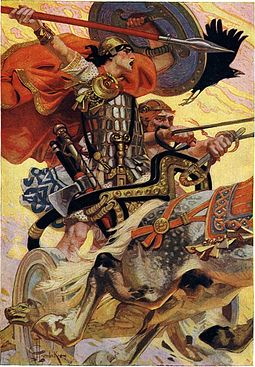
There is an ancient standing stone in a field not far from the village of Knockbridge (Irish: Droichead an Chnoic) known locally as ‘The Field of Slaughter'. It stands at 3 m (10 ft) tall and 1.3 m (over 4 ft) wide and is thought to date to the Bronze Age (2,400 - 500 BC). This menhir is said to have been originally erected to mark the grave of a past great warrior and is called Clochafarmore (Irish: Cloch an Fhir Mhóir). Sometimes this standing stone is referred to as Cúchulainn's Stone and legend has it that it is the site where another great Irish hero and warrior, Cúchulainn, met his end.
Cú Chulainn or Cúchulainn is said to be the son of Lugh, a god in Irish mythology and member of the pre-Christian Gaelic pantheon the Tuatha Dé Danann. The Tuatha Dé Danann form a significant feature in Irish, Scottish and Manx mythology who had supernatural ability and were of great importance to the belief systems of the Gaelic people. In the Ulster Cycle, one of the four great cycles of Irish mythology, Lugh fathered Cú Chulainn with the mortal maiden Deichtine who was the sister of Conchobar mac Nessa the king of Ulster. Cúchulainn is the principal character of the epic Irish saga the Táin Bó Cuailgne commonly known as The Cattle Raid of Cooley or The Táin which is traditionally set in the 1st century AD.